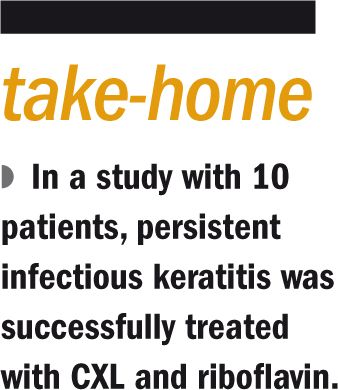Article
Promising results for keratitis treatment with use of CXL, riboflavin
Author(s):
In a study with 10 patients, persistent infectious keratitis was successfully treated with CXL and riboflavin.
By Vanessa Caceres
Infectious keratitis is a potentially blinding disease, and some cases are challenging to treat, said Ashraf H. El Habbak, MD, PhD.
Although most cases are bacterial and resolve with topical broad-spectrum antibiotics, emerging antibiotic-resistant ulcers remain a threat, said Dr. El Habbak, professor, Department of Ophthalmology, Benha University, Egypt.

This has led to increased interest in the use of corneal crosslinking (CXL) to treat infectious keratitis, Dr. El Habbak said.
Corneal crosslinking is already used for keratoconus and other forms of corneal ectasia.
“Ultraviolet rays and topical riboflavin change the physiochemical properties of corneal collagen and by increasing its stiffness,” he said. “These changes increase the collagen resistance to the bacterial degradation enzymes.”
There are in vitro studies that address the efficacy of riboflavin and ultraviolet CXL against various pathogens, including methicillin-resistant Staphyloccocus aureus, multi drug-resistant Pseudomonas, and drug-resistant Streptococcus pneumoniae.
“However, clinical reports proving the efficacy of riboflavin UV/crosslinking in the treatment of microbial keratitis and arresting the corneal melts are still limited,” Dr. El Habbak said.
Dr. El Habbak presented results from 10 eyes of 10 patients who were treated with riboflavin and UV CXL for refractory infectious keratitis. All patients had been treated with both topical and systemic antibiotics but had not responded to the treatments over 2 weeks. The antibiotics included fortified vancomycin (50 mg/ml) and ceftazidime (50 mg/ml) plus topical amphotericin B (0.1 mg/ml) if there was also a fungal infection. Systemic therapy included ciprofloxacin and linezolid as well as amphotericin B for fungal infections.
The antimicrobials were stopped for 24 hours, and a corneal swab was performed to search for the bacterial or fungal infection source, Dr. El Habbak said.
Patients also were assessed via slit lamp exams and photos, best-corrected visual acuity (BCVA), and ultrasound pachymetry of their corneal thickness.
Patients were treated with UV CXL and 0.1% riboflavin drops used every 3 minutes for 30 minutes.
After treatment, topical and systemic antibiotics were continued for 1 week. Follow-up visits were at 1 week, 1 month, and 3 months. All patients had their BCVA measured, a corneal swab performed, and slit lamp-colored corneal photos taken.
“Progression of keratitis was stopped in all cases,” Dr. El Habbak said. “The mean BCVA improved from 0.9 logMAR pre-CXL to 0.1 logMAR 3 months after treatment.”
Pain also improved in all cases. None of the 10 cases required emergency keratoplasty, the latter of which could lead to rejection or reinfection.
The results support other published literature regarding the use of CXL and antibiotics combined or CXL as a solo treatment, Dr. El Habbak said.
Although infectious keratitis must be managed with extreme caution, the use of CXL appears to be a promising adjuvant therapy, Dr. El Habbak concluded.
Ashraf H. El Habbak, MD, PhD
e: a.elhabbak@fmed.bu.edu.eg
This article was adapted from Dr. El Habbak’s presentation during Refractive Subspecialty Day at the 2017 meeting of the American Academy of Ophthalmology. Dr. El Habbak has no disclosures.
Newsletter
Don’t miss out—get Ophthalmology Times updates on the latest clinical advancements and expert interviews, straight to your inbox.




